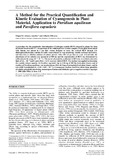Mostrar el registro sencillo del ítem
A method for the practical quantification and Kinetic evaluation of Cyanogenesis in plant material. application to Pteridium aquilinum and Passiflora capsularis.
| dc.rights.license | http://creativecommons.org/licenses/by-nc-sa/3.0/ve/ | |
| dc.contributor.author | Oliveros Bastidas, Alberto | es_VE |
| dc.contributor.author | Alonso Amelot, Miguel | es_VE |
| dc.date | 2006-02-24 | es_VE |
| dc.date.accessioned | 2006-02-24T09:00:00Z | |
| dc.date.available | 2006-02-24T09:00:00Z | |
| dc.date.created | 2000-01-01 | es_VE |
| dc.date.issued | 2006-02-24T09:00:00Z | es_VE |
| dc.identifier.other | T016300002007/0 | es_VE |
| dc.identifier.uri | http://www.saber.ula.ve/handle/123456789/16802 | |
| dc.description.abstract | A method for the practical quantification and Kinetic evaluation of Cyanogenesis in plant material. application to Pteridium aquilinum and Passiflora capsularis (Alonso Amelot, Miguel and Oliveros, Alberto) Abstract A procedure for the quantitative determination of hydrogen cyanide (HCN) released by plants has been developed based on the UV-vis spectrum of the sodium picrate-cyanide complex. Fresh plant tissue mixed with toluene was placed in a gas flow system designed to carry the evolved HCN through 2,4- dinitrophenylhydrazine solution in acidic water:ethanol to trap interfering volatile carbonyl derivatives, and then into an alkaline solution of sodium picrate. After 18 h of gas flow at a rate of 6 mL/min, the absorbance of the solution was measured at 500 nm and the concentration of HCN was determined by calibration in the range 10-3 - 10-5 M. The molar absorptivity coefficient (1.385 L/cm M) yielded a detection limit of 2.6 x 10-6 mol/L and a 92.6 ± 2.6% recovery yield of HCN. The method was applied to determine the cyanide release capacity of Passiflora capsularis (up to 3.34 mg of HCN/g fresh plant tissue), and of croziers of Pteridium aquilinum var arachnoideum (10.4-61.3 mg of prunasin/g fresh plant tissue), and its rate of HCN production (K = 2.20 ± 0.01 x 10-4/s). Cymbopogon citratum, known to release large quantities of volatile, potentially interfering, monoterpene ketones and aldehydes, gave a negative reaction. Copyright © 2000 John Wiley & Sons, Ltd. This article was published on Phytochemical Analysis Phytochem. Anal. 11, 309-316 (2000) | es_VE |
| dc.format.extent | 120904 | es_VE |
| dc.language.iso | es | es_VE |
| dc.publisher | SABER ULA | es_VE |
| dc.rights | info:eu-repo/semantics/openAccess | |
| dc.subject | Grupo de Química Ecológica | es_VE |
| dc.title | A method for the practical quantification and Kinetic evaluation of Cyanogenesis in plant material. application to Pteridium aquilinum and Passiflora capsularis. | es_VE |
| dc.type | info:eu-repo/semantics/article | |
| dc.description.email | aloliver@ula.ve | es_VE |
| dc.description.email | alonso@ula.ve | es_VE |
| dc.description.tiponivel | Nivel monográfico | es_VE |
| dc.subject.departamento | Departamento de Química | es_VE |
| dc.subject.escuela | Escuela de Ciencias. | es_VE |
| dc.subject.facultad | Facultad de Ciencias. | es_VE |
| dc.subject.keywords | Cyanogenesis | es_VE |
| dc.subject.keywords | Quantitative method | es_VE |
| dc.subject.keywords | Kinetics | es_VE |
| dc.subject.keywords | Sodium picrate | es_VE |
| dc.subject.keywords | Carbonyl interference | es_VE |
| dc.subject.keywords | Cymbopogon citratum | es_VE |
| dc.subject.keywords | Passiflora capsularis | es_VE |
| dc.subject.keywords | Pteridium aquilinum | es_VE |
| dc.subject.tipo | Artículos | es_VE |
Ficheros en el ítem
Este ítem aparece en la(s) siguiente(s) colección(ones)
-
Articulos, Pre-prints (Facultad de Ciencias)
-
Articulos, Pre-prints (Grupo de Química Ecológica)
Articulos, Pre-prints del Grupo de Química Ecológica


